Mary Pickford (1892-1979) was a legendary silent film actress and was known as 'America’s sweetheart.' She was a founder of United Artists and helped to establish the Academy.

German postcard by Ross Verlag, no. 838/1. Photo: Terra Film A.G., Berlin. Publicity still for Rosita (Ernst Lubitsch, 1923).

French postcard by Europe, no. 710. Photo: United Artists. Publicity still for Dorothy Vernon of Haddon Hall (Marshall Neilan, 1924).

German postcard by Ross Verlag, no. 3100/2, 1928-1929. Photo: United Artists.

German postcard by Ross Verlag, no. 4778/1, 1929-1930. Photo: Ifa / United Artists. Publicity still for Coquette (Sam Taylor, 1929).

German postcard by Ross Verlag, no. 5214/1, 1930-1931. Photo: publicity still for The Taming of the Shrew (Sam Taylor, 1929).
Mary Pickford was born Gladys Mary Smith in 1892, in Toronto, Canada. She was the sister of actor/director Jack Pickford and stage/screen actress Lottie Pickford.
Pickford began performing at the age of five on the stage and was known for a time as 'Baby Gladys.' After her father was killed in an accident, Gladys became the family’s main breadwinner by performing in the theatre. She was seven years old.
The stage became a family venture, as her younger siblings Lottie and Jack and even her mother took up the trade. After touring in different shows and productions for more than nine years, Gladys went to New York to conquer Broadway.
In 1907, she made her Broadway debut in The Warrens of Virginia, produced by the famous director-producer David Belasco. He insisted that Gladys Smith would assume the stage name Mary Pickford.
In 1909, when Pickford was between stage engagements, she approached David Wark Griffith, director and head of the Biograph Company (American Mutoscope & Biograph) in New York and asked him for work in moving pictures.
Pickford had no intention of working permanently in the new medium, but hoped the income would tide her over before she went back to Belasco and the stage. That same year, 'the girl with the curls' appeared in 40 films for Biograph (according to some sources even 51 films).
In January 1910, Griffith moved his operation to California, and Pickford went with him. Actors were not listed in the credits of the Biograph pictures. Audiences noticed and identified Pickford within weeks of her first film appearance.
Exhibitors in turn capitalised on her popularity by advertising on sandwich boards that a film featuring 'The Girl with the Golden Curls' or 'The Biograph Girl' was inside.

French postcard by Cinemagazine-Edition, no. 4 Photo: Evans L.A.

British postcard by Rotary Photo, London, no. S 62-4. Photo: Moody, N.Y. Caption: "This is a Real Photograph on Rajar Bromide Card."
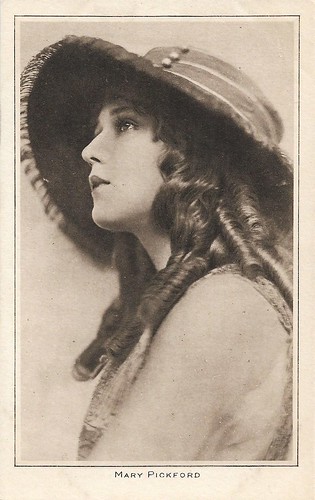
British postcard in the 'Pictures' Portrait Gallery, London.

German postcard by Ross Verlag, no. 1165/1, 1927-1928. Photo: Ifa / United Artists.
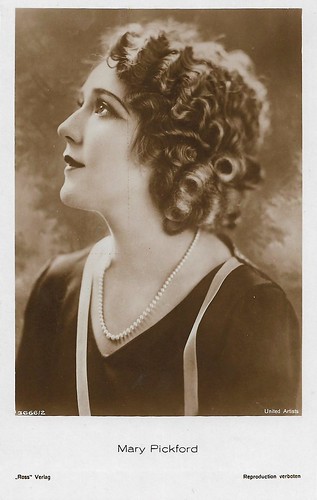
German postcard by Ross Verlag, no. 3666/2, 1928-1929. Photo: United Artists.
Mary Pickford stayed with the Biograph Company, working as both an actress and writer from 1909 to 1911. She left Biograph in December 1910 for a brief stint at Carl Laemmle's Independent Moving Pictures Company (IMP). Unhappy with their creative standards, Pickford returned to work with Griffith. Some of her best performances were in his films, such as Friends (D.W. Griffith, 1912) with Henry B. Walthall, The Mender of Nets (D.W. Griffith, 1912) with Mabel Normand, and The Female of the Species (D.W. Griffith, 1912).
In 1913, after a run on Broadway in 'A Good Little Devil', Pickford made a definitive break from the stage by signing a film contract with Adolph Zukor who had formed one of the first American feature film companies: Famous Players in Famous Plays later known as Paramount Pictures.
Hearts Adrift (Edwin S. Porter, 1914) made her irresistible to filmgoers. With Harold Lockwood, she played a man and a woman who are shipwrecked on a desert island. It doesn't take long before they fall in love and, figuring that they would never see civilisation again, declare themselves married ... The film was so popular that Pickford asked for the first of her many publicised pay raises based on the profits and reviews. The film marked the first time Pickford’s name was featured above the title on cinema marquees.
Tess of the Storm Country (Edwin S. Porter, 1914) was released five weeks later. Mary played a fiery young woman fighting for the underclass. The film caused a sensation. Biographer Kevin Brownlow observed that the film "sent her career into orbit and made her the most popular actress in America, if not the world." Over the years, her fame grew as well as her salary. In 1916, Pickford had negotiated a contract that gave her a $10,000 a week salary, 50% of her film profits, and her own production company.
'Little Mary' became an international star, beloved for her beauty and charm. She often appeared on screen in young girl roles, even when she was an adult. Some of Mary Pickford’s greatest films were a collaborative effort with friend and writer-director Frances Marion. Together they worked on such hits as Rebecca of Sunnybrook Farm (Marshall Neilan, 1917) and Poor Little Rich Girl (Maurice Tourneur, 1917).
Christel Schmidt at Women Film Pioneers Project: "Pickford is often remembered for her portrayals of children in films including Rebecca of Sunnybrook Farm (1917) and Daddy-Long-Legs (1919). The stories were adapted from popular novels and had been performed on stage with an adult actress (Edith Taliaferro and Ruth Chatterton) playing the role of a young girl. Pickford’s petite size and youthful beauty made her ideal for these parts, but it was her acting talent that seared these roles into the public consciousness."
Mary Pickford also worked as a producer. In 1919, when she was only twenty-seven years old, Pickford cofounded United Artists, the first independent film distribution company along with D.W. Griffith, Charlie Chaplin, and Douglas Fairbanks, Sr., She had been married to actor Owen Moore since 1911, but in 1920, she divorced him to be with Fairbanks.
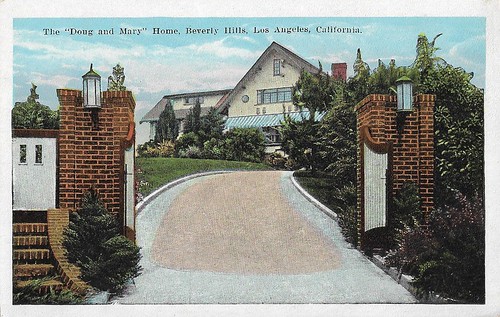
American postcard by California Postcard Company, Los Angeles. Pickfair. The "Doug (Douglas Fairbanks) and Mary" (Mary Pickford) Home, Beverly Hills, Los Angeles, California.
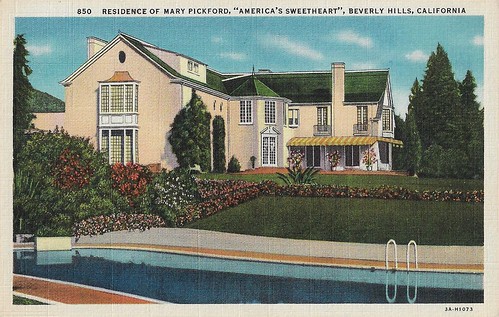
American postcard by Western Publishing & Novelty Co., Los Angeles, no. 850. Pickfair. Residence of Mary Pickford, "America's sweetheart" (and Douglas Fairbanks), Beverly Hills, California.
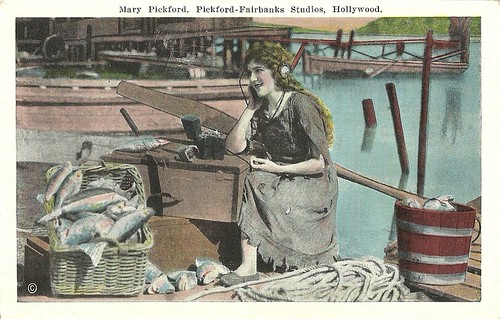
American postcard by California Postcard Co., Los Angeles. Photo: Glen G. Stone, Los Angeles. Mary Pickford in the title role of Tess of the Storm Country (John S. Robertson, 1922), on location, speaking by a radiophone with her studio at Hollywood, at thirty miles distant.

French postcard in the Les Vedettes de Cinéma series by A.N., Paris, no. 85. Photo: United Artists. Charlie Chaplin, Mary Pickford and Douglas Fairbanks, Sr., the 'United Artists'.

Vintage postcard, no. 960/2. Probably a vintage reprint of a Ross Verlag postcard. In 1926, Pickford and Douglas Fairbanks, Sr. visited Berlin and stayed at the Hotel Adlon near the Brandenburg Gate, which is in the background of this picture.
Mary Pickford and Douglas Fairbanks, Sr married in 1920, becoming one of Hollywood’s earliest supercouples. Fans adored the pairing, and the couple was mobbed at every port on their whirlwind European honeymoon. The couple were known to host fabulous events at their home, called Pickfair, which were attended by many of the leading figures in film.
In the 1920s, Pickford continued to score more box-office hits with Polyanna (Paul Powell, 1920), Little Lord Fauntleroy (Alfred E. Green, Jack Pickford, 1921) with Claude Gillingwater, and a new version of Tess of the Storm Country (John S. Robertson, 1922).
German director Ernst Lubitsch came to America at Mary's invitation to direct Dorothy Vernon of Haddon Hall (1924), but when he arrived he had changed his mind and would not do it. The film was eventually directed by Marshall Neilan. Instead, Ernst Lubitsch and Mary Pickford made Rosita (1923) together.
Another hit was Little Annie Rooney (William Beaudine, 1925) with William Haines, and her last silent film, My Best Girl (Sam Taylor, 1927) with Charles 'Buddy' Rogers, would be one of the greatest of the era.
Mary Pickford was one of the original 36 founders of the Academy of Motion Picture Arts and Sciences in 1927. Around this time, the film industry was changing and talking pictures were on the rise. In 1929, Pickford starred in her first sound film, Coquette (Sam Taylor, 1929), which explored the dark side of a wealthy family. She won an Academy Award for her work on the film.
Still she was never quite able to recreate the phenomenal success she had in the silent pictures with the sound films. Her last film was Secrets (Frank Borzage, 1933) with Leslie Howard. Mary Pickford retired from the screen in 1933 but continued to produce.
Pickford, whose professional decline had begun in the same year as the death of her beloved mother, Gladys, in 1928, saw her brother and sister die in the 1930s. In 1936, her fairytale marriage to Fairbanks ended in divorce. Fairbanks died of heart failure only three years later.
In 1937, Pickford married actor and band leader Charles 'Buddy' Rogers, her costar in My Best Girl. They stayed together until her death and adopted two children. Mary Pickford died in 1979 in Santa Monica, California.
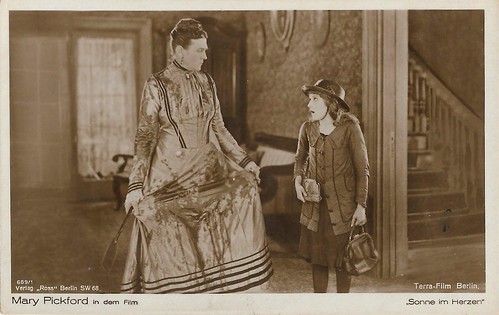
German postcard by Ross Verlag, no. 689/1, 1919-1924. Photo: Terra-Film, Berlin. Publicity still of Katherine Griffith and Mary Pickford in Pollyanna (Paul Powell, 1920), released in Germany as Sonne im Herzen (Sunshine in her Heart).

German postcard by Ross Verlag, no. 683/5. Photo: Terra Film A.G., Berlin. Publicity still for Rosita (Ernst Lubitsch, 1923).

German postcard by Ross Verlag, no. 839/4. Photo: Terra Film A.G., Berlin. Publicity still for Dorothy Vernon of Haddon Hall (Marshall Neilan, 1924).

Austrian postcard by Iris Verlag, no. 906. Photo: United Artists / Projectograph-Film. Publicity still for Sparrows (William Beaudine, 1926).

German postcard by Ross Verlag, no. 47784/2, 1929-1930. Photo: United Artists. Publicity still for Coquette (Sam Taylor, 1929).

German postcard by Ross Verlag, no. 5214/2, 1930-1931. Photo: publicity still for Taming of the Shrew (Sam Taylor, 1929).
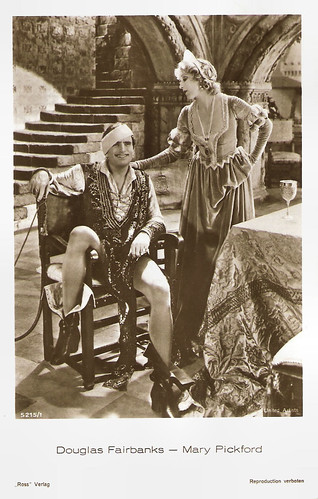
German postcard by Ross-Verlag, no. 5215/4 1930-1931. Photo: United Artists. Publicity still for The Taming of the Shrew (Sam Taylor, 1930) with Douglas Fairbanks Sr..
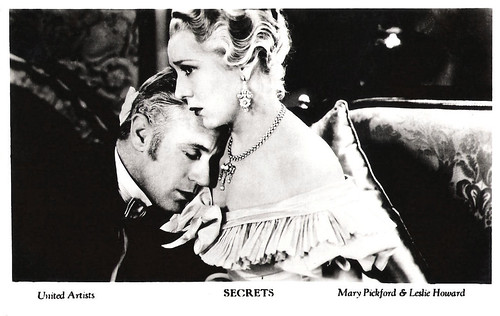
British postcard. Photo: United Artists. Publicity still for Secrets (Frank Borzage, 1933) with Leslie Howard.
Sources: Christel Schmidt (Women's Film Pioneer Project), Biography.com, Wikipedia and IMDb.

German postcard by Ross Verlag, no. 838/1. Photo: Terra Film A.G., Berlin. Publicity still for Rosita (Ernst Lubitsch, 1923).

French postcard by Europe, no. 710. Photo: United Artists. Publicity still for Dorothy Vernon of Haddon Hall (Marshall Neilan, 1924).

German postcard by Ross Verlag, no. 3100/2, 1928-1929. Photo: United Artists.

German postcard by Ross Verlag, no. 4778/1, 1929-1930. Photo: Ifa / United Artists. Publicity still for Coquette (Sam Taylor, 1929).

German postcard by Ross Verlag, no. 5214/1, 1930-1931. Photo: publicity still for The Taming of the Shrew (Sam Taylor, 1929).
The Girl with the Golden Curls
Mary Pickford was born Gladys Mary Smith in 1892, in Toronto, Canada. She was the sister of actor/director Jack Pickford and stage/screen actress Lottie Pickford.
Pickford began performing at the age of five on the stage and was known for a time as 'Baby Gladys.' After her father was killed in an accident, Gladys became the family’s main breadwinner by performing in the theatre. She was seven years old.
The stage became a family venture, as her younger siblings Lottie and Jack and even her mother took up the trade. After touring in different shows and productions for more than nine years, Gladys went to New York to conquer Broadway.
In 1907, she made her Broadway debut in The Warrens of Virginia, produced by the famous director-producer David Belasco. He insisted that Gladys Smith would assume the stage name Mary Pickford.
In 1909, when Pickford was between stage engagements, she approached David Wark Griffith, director and head of the Biograph Company (American Mutoscope & Biograph) in New York and asked him for work in moving pictures.
Pickford had no intention of working permanently in the new medium, but hoped the income would tide her over before she went back to Belasco and the stage. That same year, 'the girl with the curls' appeared in 40 films for Biograph (according to some sources even 51 films).
In January 1910, Griffith moved his operation to California, and Pickford went with him. Actors were not listed in the credits of the Biograph pictures. Audiences noticed and identified Pickford within weeks of her first film appearance.
Exhibitors in turn capitalised on her popularity by advertising on sandwich boards that a film featuring 'The Girl with the Golden Curls' or 'The Biograph Girl' was inside.

French postcard by Cinemagazine-Edition, no. 4 Photo: Evans L.A.

British postcard by Rotary Photo, London, no. S 62-4. Photo: Moody, N.Y. Caption: "This is a Real Photograph on Rajar Bromide Card."

British postcard in the 'Pictures' Portrait Gallery, London.

German postcard by Ross Verlag, no. 1165/1, 1927-1928. Photo: Ifa / United Artists.

German postcard by Ross Verlag, no. 3666/2, 1928-1929. Photo: United Artists.
The Most Popular Actress in America, if not the World
Mary Pickford stayed with the Biograph Company, working as both an actress and writer from 1909 to 1911. She left Biograph in December 1910 for a brief stint at Carl Laemmle's Independent Moving Pictures Company (IMP). Unhappy with their creative standards, Pickford returned to work with Griffith. Some of her best performances were in his films, such as Friends (D.W. Griffith, 1912) with Henry B. Walthall, The Mender of Nets (D.W. Griffith, 1912) with Mabel Normand, and The Female of the Species (D.W. Griffith, 1912).
In 1913, after a run on Broadway in 'A Good Little Devil', Pickford made a definitive break from the stage by signing a film contract with Adolph Zukor who had formed one of the first American feature film companies: Famous Players in Famous Plays later known as Paramount Pictures.
Hearts Adrift (Edwin S. Porter, 1914) made her irresistible to filmgoers. With Harold Lockwood, she played a man and a woman who are shipwrecked on a desert island. It doesn't take long before they fall in love and, figuring that they would never see civilisation again, declare themselves married ... The film was so popular that Pickford asked for the first of her many publicised pay raises based on the profits and reviews. The film marked the first time Pickford’s name was featured above the title on cinema marquees.
Tess of the Storm Country (Edwin S. Porter, 1914) was released five weeks later. Mary played a fiery young woman fighting for the underclass. The film caused a sensation. Biographer Kevin Brownlow observed that the film "sent her career into orbit and made her the most popular actress in America, if not the world." Over the years, her fame grew as well as her salary. In 1916, Pickford had negotiated a contract that gave her a $10,000 a week salary, 50% of her film profits, and her own production company.
'Little Mary' became an international star, beloved for her beauty and charm. She often appeared on screen in young girl roles, even when she was an adult. Some of Mary Pickford’s greatest films were a collaborative effort with friend and writer-director Frances Marion. Together they worked on such hits as Rebecca of Sunnybrook Farm (Marshall Neilan, 1917) and Poor Little Rich Girl (Maurice Tourneur, 1917).
Christel Schmidt at Women Film Pioneers Project: "Pickford is often remembered for her portrayals of children in films including Rebecca of Sunnybrook Farm (1917) and Daddy-Long-Legs (1919). The stories were adapted from popular novels and had been performed on stage with an adult actress (Edith Taliaferro and Ruth Chatterton) playing the role of a young girl. Pickford’s petite size and youthful beauty made her ideal for these parts, but it was her acting talent that seared these roles into the public consciousness."
Mary Pickford also worked as a producer. In 1919, when she was only twenty-seven years old, Pickford cofounded United Artists, the first independent film distribution company along with D.W. Griffith, Charlie Chaplin, and Douglas Fairbanks, Sr., She had been married to actor Owen Moore since 1911, but in 1920, she divorced him to be with Fairbanks.

American postcard by California Postcard Company, Los Angeles. Pickfair. The "Doug (Douglas Fairbanks) and Mary" (Mary Pickford) Home, Beverly Hills, Los Angeles, California.

American postcard by Western Publishing & Novelty Co., Los Angeles, no. 850. Pickfair. Residence of Mary Pickford, "America's sweetheart" (and Douglas Fairbanks), Beverly Hills, California.

American postcard by California Postcard Co., Los Angeles. Photo: Glen G. Stone, Los Angeles. Mary Pickford in the title role of Tess of the Storm Country (John S. Robertson, 1922), on location, speaking by a radiophone with her studio at Hollywood, at thirty miles distant.

French postcard in the Les Vedettes de Cinéma series by A.N., Paris, no. 85. Photo: United Artists. Charlie Chaplin, Mary Pickford and Douglas Fairbanks, Sr., the 'United Artists'.

Vintage postcard, no. 960/2. Probably a vintage reprint of a Ross Verlag postcard. In 1926, Pickford and Douglas Fairbanks, Sr. visited Berlin and stayed at the Hotel Adlon near the Brandenburg Gate, which is in the background of this picture.
One of Hollywood’s Earliest Supercouples
Mary Pickford and Douglas Fairbanks, Sr married in 1920, becoming one of Hollywood’s earliest supercouples. Fans adored the pairing, and the couple was mobbed at every port on their whirlwind European honeymoon. The couple were known to host fabulous events at their home, called Pickfair, which were attended by many of the leading figures in film.
In the 1920s, Pickford continued to score more box-office hits with Polyanna (Paul Powell, 1920), Little Lord Fauntleroy (Alfred E. Green, Jack Pickford, 1921) with Claude Gillingwater, and a new version of Tess of the Storm Country (John S. Robertson, 1922).
German director Ernst Lubitsch came to America at Mary's invitation to direct Dorothy Vernon of Haddon Hall (1924), but when he arrived he had changed his mind and would not do it. The film was eventually directed by Marshall Neilan. Instead, Ernst Lubitsch and Mary Pickford made Rosita (1923) together.
Another hit was Little Annie Rooney (William Beaudine, 1925) with William Haines, and her last silent film, My Best Girl (Sam Taylor, 1927) with Charles 'Buddy' Rogers, would be one of the greatest of the era.
Mary Pickford was one of the original 36 founders of the Academy of Motion Picture Arts and Sciences in 1927. Around this time, the film industry was changing and talking pictures were on the rise. In 1929, Pickford starred in her first sound film, Coquette (Sam Taylor, 1929), which explored the dark side of a wealthy family. She won an Academy Award for her work on the film.
Still she was never quite able to recreate the phenomenal success she had in the silent pictures with the sound films. Her last film was Secrets (Frank Borzage, 1933) with Leslie Howard. Mary Pickford retired from the screen in 1933 but continued to produce.
Pickford, whose professional decline had begun in the same year as the death of her beloved mother, Gladys, in 1928, saw her brother and sister die in the 1930s. In 1936, her fairytale marriage to Fairbanks ended in divorce. Fairbanks died of heart failure only three years later.
In 1937, Pickford married actor and band leader Charles 'Buddy' Rogers, her costar in My Best Girl. They stayed together until her death and adopted two children. Mary Pickford died in 1979 in Santa Monica, California.

German postcard by Ross Verlag, no. 689/1, 1919-1924. Photo: Terra-Film, Berlin. Publicity still of Katherine Griffith and Mary Pickford in Pollyanna (Paul Powell, 1920), released in Germany as Sonne im Herzen (Sunshine in her Heart).

German postcard by Ross Verlag, no. 683/5. Photo: Terra Film A.G., Berlin. Publicity still for Rosita (Ernst Lubitsch, 1923).

German postcard by Ross Verlag, no. 839/4. Photo: Terra Film A.G., Berlin. Publicity still for Dorothy Vernon of Haddon Hall (Marshall Neilan, 1924).

Austrian postcard by Iris Verlag, no. 906. Photo: United Artists / Projectograph-Film. Publicity still for Sparrows (William Beaudine, 1926).

German postcard by Ross Verlag, no. 47784/2, 1929-1930. Photo: United Artists. Publicity still for Coquette (Sam Taylor, 1929).

German postcard by Ross Verlag, no. 5214/2, 1930-1931. Photo: publicity still for Taming of the Shrew (Sam Taylor, 1929).

German postcard by Ross-Verlag, no. 5215/4 1930-1931. Photo: United Artists. Publicity still for The Taming of the Shrew (Sam Taylor, 1930) with Douglas Fairbanks Sr..

British postcard. Photo: United Artists. Publicity still for Secrets (Frank Borzage, 1933) with Leslie Howard.
Sources: Christel Schmidt (Women's Film Pioneer Project), Biography.com, Wikipedia and IMDb.
No comments:
Post a Comment